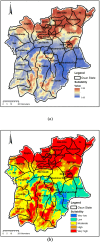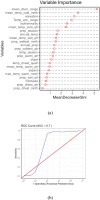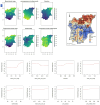Modelling species distribution of Anopheles gambiae s.l. in Osun state using random forest modeling approach
- PMID: 40360721
- PMCID: PMC12075671
- DOI: 10.1038/s41598-025-95001-1
Modelling species distribution of Anopheles gambiae s.l. in Osun state using random forest modeling approach
Abstract
Malaria continues to be a public health problem in Nigeria. Effective vector control has been acknowledged as one of the major strategies to combat malaria in Nigeria. In order to inform context-specific policies, there is need to understand the species niche/colonization and geographical distribution of local Anopheles mosquitoes in different geographical areas in Nigeria. Therefore, this study was designed to model the distribution of Anopheles gambiae s.l. in Osun State, Nigeria. Immature stages of Anopheles mosquitoes were collected from 17 Local Government Areas (LGAs) of Osun State between 2022 and 2023, resulting in the identification of over 20,000 Anopheline mosquitoes. Of these, 146 breeding sites were identified. Two sibling species of An. gambiae s.l were later confirmed using molecular techniques (An. gambiae s.s. and An. coluzzii) with 99% of the Anopheles being An. coluzzii in all the 17 LGAs. The results were modelled using Random Forest to predict their potentially suitable habitats across the entire state. A total of 23 environmental variables (19 bioclimatic and four topographic) were used in the model, resulting in maps of the potential geographical distribution of dominant vector species under current climatic conditions. The model suggests that members of the Anopheles gambiae s.l. encountered would be found in the three senatorial districts (from high to moderate), with more suitable areas in the central part of the state. Temperature-related climatic conditions seems to be ranked higher in order of variable importance that contributed to the distribution of these species. Mean diurnal range (monthly temperature fluctuation) and temperature of the coldest month seem to be strongly associated with the presence of these species. Our model suggested areas with higher monthly temperature fluctuations in the state (between 9 and 10 °C) to support the breeding of Anopheles species, and they are likely to be abundant in areas with lower temperature during the coldest month (wet season) of the year (between 18 and 19 °C). The results of this study provide a baseline data allowing decision-makers to monitor the distribution of these species and establish a management plan for future mosquito surveillance and control programs in Osun State.
Keywords: Anopheles; Larval distribution; Modelling; Osun state.
© 2025. The Author(s).
Conflict of interest statement
Declarations. Competing interests: The authors declare no competing interests.
Figures





Similar articles
-
Spatial distribution and ecological niche modeling of geographical spread of Anopheles gambiae complex in Nigeria using real time data.Sci Rep. 2023 Aug 22;13(1):13679. doi: 10.1038/s41598-023-40929-5. Sci Rep. 2023. PMID: 37608210 Free PMC article.
-
Sibling species of the major malaria vector Anopheles gambiae display divergent preferences for aquatic breeding sites in southern Nigeria.Malar J. 2024 Feb 27;23(1):60. doi: 10.1186/s12936-024-04871-9. Malar J. 2024. PMID: 38413961 Free PMC article.
-
Spatial distribution and geospatial modeling of potential spread of secondary malaria vectors species in Nigeria using recently collected empirical data.PLoS One. 2025 Apr 21;20(4):e0320531. doi: 10.1371/journal.pone.0320531. eCollection 2025. PLoS One. 2025. PMID: 40258055 Free PMC article.
-
Anopheles larval species composition and characterization of breeding habitats in two localities in the Ghibe River Basin, southwestern Ethiopia.Malar J. 2020 Feb 11;19(1):65. doi: 10.1186/s12936-020-3145-8. Malar J. 2020. PMID: 32046734 Free PMC article.
-
Assessing Anopheles vector species diversity and transmission of malaria in four health districts along the borders of Côte d'Ivoire.Malar J. 2021 Oct 18;20(1):409. doi: 10.1186/s12936-021-03938-1. Malar J. 2021. PMID: 34663359 Free PMC article.
References
-
- World malaria report 2022. Licence: CC BY-NC-SA 3.0 IGO (World Health Organization, 2022).
-
- World malaria report 2023. Licence: CC BY-NC-SA 3.0 IGO (World Health Organization, 2022).
-
- Awolola, T. S., Oyewole, I. O., Koekemoer, L. L. & Coetzee, M. Identification of three members of An. funestus (Diptera: Culicidae) group and their role in malaria transmission in two ecological zones in Nigeria. R Soc. Trop. Med. Hyg.99, 525–531 (2005). - PubMed
-
- Coetzee, M. et al. Anopheles coluzziii and Anopheles amharicus, new members of the Anopheles Gambiae S.l. Zootaxa3619, 246–274 (2013). - PubMed
MeSH terms
LinkOut - more resources
Full Text Sources

